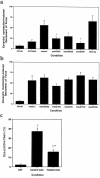Aminoglycoside antibiotics restore dystrophin function to skeletal muscles of mdx mice
- PMID: 10449429
- PMCID: PMC481050
- DOI: 10.1172/JCI7866
Aminoglycoside antibiotics restore dystrophin function to skeletal muscles of mdx mice
Abstract
Duchenne muscular dystrophy (DMD) is caused by mutations in the dystrophin gene, leading to the absence of the dystrophin protein in striated muscle. A significant number of these mutations are premature stop codons. On the basis of the observation that aminoglycoside treatment can suppress stop codons in cultured cells, we tested the effect of gentamicin on cultured muscle cells from the mdx mouse - an animal model for DMD that possesses a premature stop codon in the dystrophin gene. Exposure of mdx myotubes to gentamicin led to the expression and localization of dystrophin to the cell membrane. We then evaluated the effects of differing dosages of gentamicin on expression and functional protection of the muscles of mdx mice. We identified a treatment regimen that resulted in the presence of dystrophin in the cell membrane in all striated muscles examined and that provided functional protection against muscular injury. To our knowledge, our results are the first to demonstrate that aminoglycosides can suppress stop codons not only in vitro but also in vivo. Furthermore, these results raise the possibility of a novel treatment regimen for muscular dystrophy and other diseases caused by premature stop codon mutations. This treatment could prove effective in up to 15% of patients with DMD.
Figures





Comment in
-
Correction of genetic disease by making sense from nonsense.J Clin Invest. 1999 Aug;104(4):367-8. doi: 10.1172/JCI8055. J Clin Invest. 1999. PMID: 10449426 Free PMC article. Review. No abstract available.
References
-
- Moser H. Duchenne muscular dystrophy: pathogenic aspects and genetic prevention. Hum Genet. 1984;66:17–40. - PubMed
-
- Koenig M, Monaco AP, Kunkel LM. The complete sequence of dystrophin predicts a rod-shaped cytoskeletal protein. Cell. 1988;53:219–228. - PubMed
-
- Koenig M, et al. Complete cloning of the Duchenne muscular dystrophy (DMD) cDNA and preliminary genomic organization of the DMD gene in normal and affected individuals. Cell. 1987;50:509–517. - PubMed
-
- Hoffman EP. Molecular diagnostics of Duchenne/Becker dystrophy: new additions to a rapidly expanding literature. J Neurol Sci. 1991;101:129–132. - PubMed
Publication types
MeSH terms
Substances
Grants and funding
LinkOut - more resources
Full Text Sources
Other Literature Sources
Medical
Molecular Biology Databases

